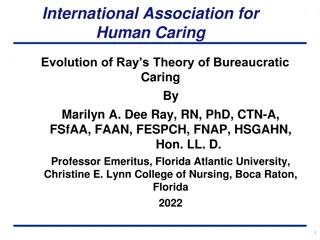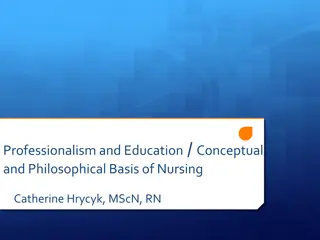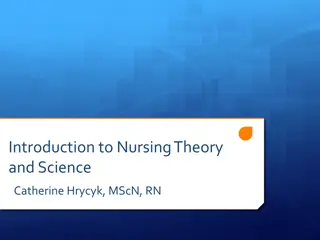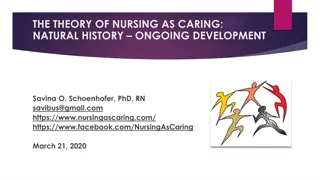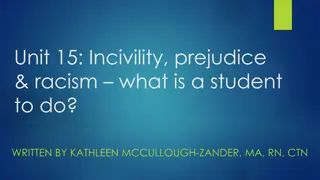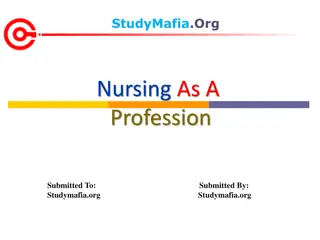Understanding Margaret Jean Watson's Human Caring Model in Nursing
Margaret Jean Watson's Human Caring Model focuses on the philosophy and science of caring in nursing, emphasizing the mind-body-spirit connection in patient care. This theoretical foundation in nursing explores the principles of holistic care and the importance of human interaction in the healing process. Watson's perception about the FF highlights the holistic approach to nursing, viewing patients as valued individuals to be respected, nurtured, and assisted towards overall well-being.
Download Presentation

Please find below an Image/Link to download the presentation.
The content on the website is provided AS IS for your information and personal use only. It may not be sold, licensed, or shared on other websites without obtaining consent from the author. Download presentation by click this link. If you encounter any issues during the download, it is possible that the publisher has removed the file from their server.
E N D
Presentation Transcript
THEORETICAL FOUNDATION IN NURSING MARGARET JEAN WATSON S HUMAN CARING MODEL DABALOS | HERNANDO | LIBERAN | LINGCOPINES | PAGALA | BSN - 1
PHILOSOPHY AND SCIENCE OF CARING Caring in nursing conveys physical acts but embraces the mind-body-spirit as its focus of attention.
Getting to Know the Theorist Getting to Know the Theorist She was born in Southern West Virginia and grew up in small town of Welch, West Virginia between 1940s to 1950s. She is a distinguished Professor and Director of Center of Human Caring, School of Nursing, University of Colorado Health Science Center, Denver. Her theory of human caring are concerned with spirit matter, flux rather than form, inner knowledge and power rather than circumstance.
Getting to Know the Theorist Getting to Know the Theorist The thoughts she had are never final and embedded with persistent values and moral imperatives related to human interaction that flows between and connects the one-caring-for and the one-cared-for. She has moved beyond contemp orary nursing to a view that is root ed in Nightingale s vision. She reflects, it is both theoretical and beyond theory.
WATSONS METAPARADIGM IN NURSING
WATSONS PERCEPTION ABOUT THE FF. Having to move educationally in the two area of stress and developmental conflicts to provide holistic care, which she believes is central practice of caring in Nursing. Asserts that nursing s social , moral and scientific contributions to humankind and society lie in its commitment to human care ideals, theory, practice and research. A valued person in and of him to be cared for, respected, nurtured, understood, and assisted. A fully functional integrated self. Viewed human as greater than and different from, the sum of its parts. Provides determine behave and what goals one should strive toward. the how values one that A high level of over-all physical, mental and social functioning should A general adaptive-maintenance level of daily functioning These change in the social, cultural, and spiritual arenas, affects the perception of the person and can lead to stress. values are affected by The absence of illness which in turn
Philosohy and Science of Caring Watson s philosophy and theory of human science can be trace to the last 25 years. 01 Beginning with the question of the relationship between human caring and nursing. 02 This become the Theory of Human Caring (1977) and Nursing: Human Science and Human Care. 03 Watson proposes seven assumptions about the science of caring and ten primary carative factors to form the framework of her theory. 04
Caring can be effectively demonstrated and practiced only interpersonally; Effective health family growth. caring and promotes individual or SEVEN ASSUMPTIONS ABOUT THE SCIENCE OF CARING Caring responses accept a person not only as he or she is now but as what he or she may become. A caring environment is one that offers the development of potential while allowing the person to choose the best action for himself or herself at a given point in time.
Caring healthogenic curing. is more than is SEVEN ASSUMPTIONS ABOUT THE SCIENCE OF CARING A science of caring is therefore complementary to the science of curing. The practice of caring is central to nursing.
10 Allowance for existential-phenomenological- spiritual forces 01 05 03 07 Cultivation of sensitivity to one s self and to others Promotion of Promotion and acceptance of the expression of positive and negative feelings; transpersonal teaching- Formation of Humanistic- altruistic system of values learning 08 02 06 04 Instillation of faith-hope Development of a helping- trusting, human caring relationship Provision for a supportive, protective, and corrective mental, physical, societal, and spiritual environment Systematic use of a creative problem-solving caring process 09 TEN CARATIVE FACTORS Assistance with gratification of human needs
ACCEPTANCE IN THE NURSING COMMUNITY EDUCATION RESEARCH PRACTICE Research must focus on both subjective and objective patient outcomes in knowing what caring is important in nursing Author of Nursing: Human Science and Human Care- Theory of Nursing Caring as an essential field in nursing Example in clinical setting: Described the core of nursing as aspects Intensive Care Units of a nurse-patient relationship Neonatal Intensive Care Units resulting in a therapeutic result. Pediatric & Gerontological units
ANALYSIS GENERALITY The theory provides moral and philosophical basis for nursing. The scope of the framework encompasses all aspects of the health- illness continuum. SIMPLICITY Watson s theory makes use of sophisticated language to put forth subtle thoughts about caring, and this entails reading between the lines to decipher its profound meaning.
ANALYSIS EMPERICAL PRECISION Watson draws heavily on widely accepted work from the other disciplines. She describes her theory as descriptive acknowledges the evolving nature of the theory and welcomes input by others. DERIVABLE CONSEQUENCES Theoretical concepts such as use of self, patient- identified needs, the caring process, and the spiritual sense of human may help nurses and their patients find meaning and harmony in increasing complexity. and she being, period of
Thank you for listening!









